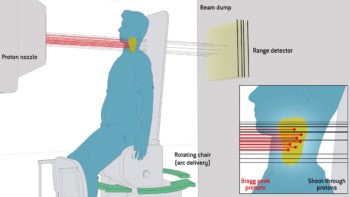Proton therapy is an increasingly popular treatment technique that uses beams of protons to accurately target and destroy cancerous tumours. A new Physics World Discovery ebook, Proton Beam Therapy, takes a close look at the physics of this cancer treatment, its benefits and the challenges associated with bringing this approach into the clinical mainstream.
The ebook is written by Harald Paganetti, director of physics research at Massachusetts General Hospital and professor of radiation oncology at Harvard Medical School. He is a pioneer in advanced Monte Carlo dose calculations for proton therapy, and is considered the world expert on the relative biological effectiveness of proton beams.
In the last few decades, proton therapy has transitioned from research laboratories into the clinical setting – making this publication particularly timely. There are currently around 60 proton therapy facilities worldwide, and this number is increasing rapidly. “Proton therapy is becoming a standard treatment option but there are still many challenges in terms of the physics, biology and clinical use of protons, which are summarized in this ebook,” Paganetti explains.
The ebook serves as ideal introductory material for students or research fellows starting to work in proton therapy. “I have received very positive feedback so far,” says Paganetti. “There are books on proton therapy physics that are several hundred pages long and provide a comprehensive view. In contrast, this ebook gives a short overview that can serve as an introduction and readers can then consult other books to go into more detail.”

Paganetti begins by discussing the benefits of proton beams – namely, that they deposit the highest energy per path length close to their end of range, enabling dose to be targeted accurately into the tumour and reducing dose to normal tissue. This offers advantages over the X-ray-based radiotherapy more commonly used to treat cancers, in which dose is deposited en route and downstream of the tumour. He outlines the physics of proton beams and how this is utilized in radiation therapy, and describes dose shaping using the two main methods of proton beam delivery: passively scattered proton beams and scanned proton pencil beams.
Next, the ebook examines some of the challenges associated with proton therapy, starting off with the technical issues involved in setting up a proton therapy facility. The text also covers challenges in the physics (dose and range uncertainties) and biology (toxicities and relative biological effectiveness) of this treatment modality, as well as the associated clinical challenges.
Paganetti finishes with a look forward. “Right now only about 1% of radiation therapy patients are treated with protons, but that number is rapidly increasing due to an increased availability of proton facilities,” he explains. “I do think that the share of proton therapy in radiation therapy will increase. Clinical efficacy will play a role, as well as economic considerations. It is thus important that we engage in clinical trials to demonstrate the value of proton therapy for various disease sites.”




